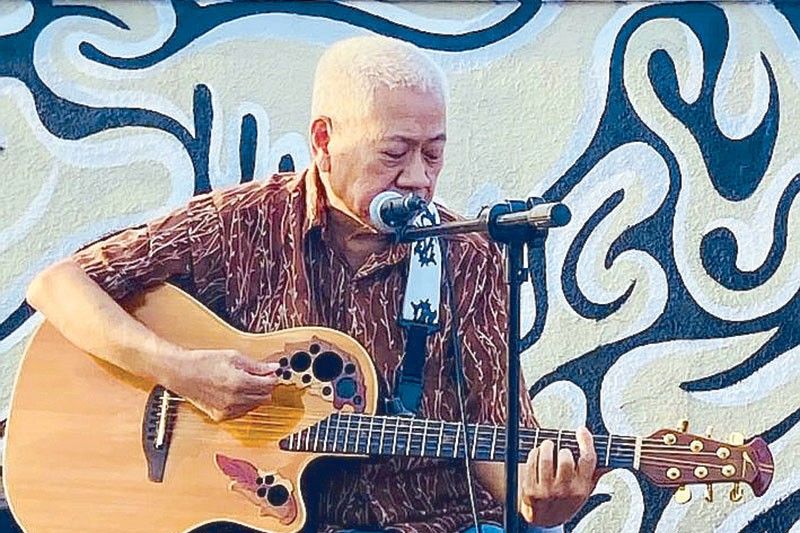Heber under the bridge, circa 1978


(Not another obit)
Heber Bartolome called me up that morning, that we should meet up at Narra dormitory in UP. It’s just that I didn’t have a cassette recorder, so we would just have to borrow from his dorm mates. He was a bit busy preparing for an upcoming exhibit at Metro Gallery. According to him, he was pressed for time as he still had five paintings to finish. But we could talk in the morning. That should be enough. Photographer? That’s taken care of. Shots were taken at a recent gig in Loyola. So, at the count of three, I was at the university looking for Heber.
I’ve known Heber for a while. Even before his face wasn’t yet full of pimples. I first saw them (Banyuhay, his band with brothers Levi and Jesse) play at dzRJ, Christmas of 1975. They didn’t receive such a good reception from the audience, as their sound was comparatively mellow because mostly acoustic. Kids at the rock club tended to favor bands loud and deafening. But their songs eventually got radio airplay. Their fans were only so many. But at the Loyola show, it was a different story. More of their songs got airplay: Oy Utol, Buhay Pinoy, Ihip ng Hangin, Tawag ni Ina. People finally understood that Pinoy rock and roll wasn’t all noise.
When I arrived at the dorm, Heber seemed pissed. There was no water again at Narra so he had to take a shower at a friend’s house in Katipunan. All in a student’s life. But make no mistake: Heber is no longer a student. He graduated from Fine Arts a couple of years ago. But he still stays in UP, because he can’t afford to stay outside campus. He also has another reason: He has to finish his thesis. But that’s alright, he can make ends meet through singing and painting.
“Let’s do the interview in the room, Jesse is waiting there, but Levi is not around because he’s giving lessons,” Heber says, smelling of cheap bath soap.
We went to the room and got started. They were able to borrow a recorder and cassette tape. Jesse just finished breakfast of banana-cue. The room was full of Heber’s paintings and prints, one of which was the origin of one of his better-known songs: “Oy utol, buto’t balat ka na’y natutulog ka pa…” And the chorus that goes, “ganyan, ganyan ganyan…”
“The problem with our music scene is the sudden obsession with adaptations,” Heber says in Tagalog. “It’s as if Filipinos no longer know how to write original songs.”
After Tag-ulan sa Tag-araw (BeeGees’ Charade), there followed more adaptations: Aalis Ka Na (Chicago’s If You Leave me Now), Awit Ko sa Iyo (Barry Manilow’s This One’s for You), and other oldies by the Beatles and Dave Clark Five. Trouble is it even gets support from contests like Salin-awit of Student Canteen. Can Filipinos no longer write their own songs? “Of course, they can. But what’s ours gets stunted because of these mestizo songs. It will pass but we have to admit that our culture goes backwards because of such songs,” Heber says, the struggling artist again sounding upset.
“The ones at fault here are the record companies. They spoon feed the masses with that kind of music. But we’ll survive that; it’s only now that composers are stepping forward,” he adds.
How’s the band today, and their contract with Dyna?
“Setup is still the three guitars of us brothers. Levi on lead. Or for variation, we ask Jesse to play violin, or Levi the mandolin, and I do a bit extra on Jew’s harp. I actually don’t like to give a label to our music. Maybe folk rock, or country rock, you really can’t say, as long as there is a Pinoy character that the listener can identify with. As for our Dyna contract, I think they’re buying Ihip ng Hangin and putting it out as a single. Nothing definite yet, but after the exhibit we’ll deal with it.”
How do you write songs? Your style is a bit literary.
“I write about what’s happening in my surroundings. Or whatever’s my feeling or mood. Like Oy Utol has sociological implications, no? Like Buhay Pinoy, about overpopulation. Whatever I feel, I write it. If I’m sad, my song is also sad. As long as it doesn’t stray from things Pinoy. Ang engot ko naman if I wrote about white Christmas or snows.”
Heber is not the only songwriter in the band. Jesse also has his own, a wedding song. And Levi writes guitar instrumentals. Heber as leader is also the arranger. He’d be producer but for lack of money. So, they need a producer. They have a sheaf of songs waiting, rough drafts.
What’s up next for the band?
“Pinoy music is about to get due recognition. A little more perseverance and hard work. Look at Mike (Hanopol) at Jem records, he’s one of their bestsellers, second only to Hajji. Now they see that rock sells. But that has long been the case, they just didn’t believe it. What Mike did was go down to the level of the masses. Buhay Musikero is really kundiman rock; just remove the electric guitars and it’s a kundiman. That’s what should be done, step down a bit to lift up the masses. That’s progress, progression. Won’t be long before we have spiritual music, the highest form of music.”
Heber delves into things of the spirit again, him being a former Ananda Marga member, strongly influenced by Eastern philosophy, George Harrison, Kwai Chiang Caine. Halihops, halihops.
Do you ever regret becoming musicians?
“Why should we? Music, like any other art, is honest. We’re glad to give a bit of ourselves to the people. For their well-being. We’ve gone through a lot of hardship. But haven’t we all? What I mean is we’ve sweated it out to attain our standing today as musicians. And since we’re here, might as well continue…”
Conference ends. Jesse a bit sleepy because couldn’t get a word in his kuya’s talkativeness. Heber can’t wait to get back to his canvases. Myself soon heading home to start writing the story. “Pinoy ba? Pinoy nga ba? Pinoy daw,” Heber says, as he begins work on a painting of a street kid under the bridge. It’s likely the rain the kid waits for, salve for his threadbare bones and skin.
(Translated from Filipino from the Jingle magazine collection of Allen Mercado, courtesy of Eric Guillermo of Jingleclan publications, written under the pseudonym Balat-Bunga.)
- Latest
- Trending


























